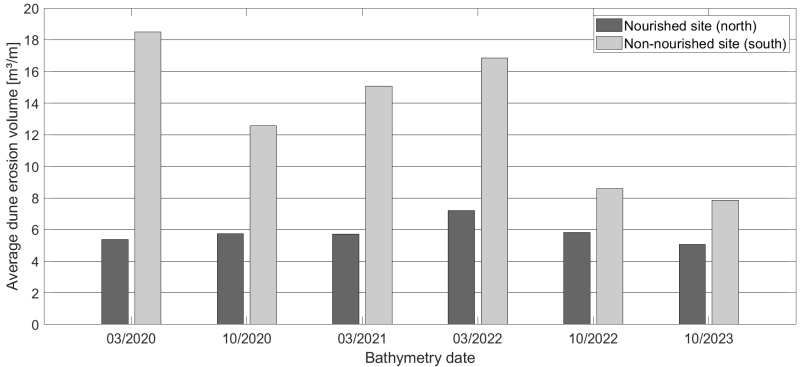Bart van der Waal1*, Merijn Niemeijer1, Anne de Beer2, Bart Grasmeijer1,2, Laura Brakenhoff3, Timothy Price1
1Utrecht University, 2Deltares, 3Rijkswaterstaat
* Corresponding author: j.b.vanderwaal@students.uu.nl
Introduction
The Dutch coast is one of the most heavily nourished coasts in the world, with ~12 Mm3 of sand being added to the coastal system annually (Brand et al., 2022) to combat chronic coastal erosion. This is necessary to ensure flood safety for the hinterland, by maintaining the nearly uninterrupted sandy beaches and, in particular, wind-blown dunes. The long-term effects of local nourishments on beach-dune development and dune erosion volumes during storms, however, remain unclear. Besides feeding the coast with sand, beach nourishments and shoreface nourishments may both act as direct buffers against dune erosion during storms. Although both types of nourishments remain present over multiple (4 -10) years (Brand et al., 2022), during which multiple storms may pass, their cumulative effect on dune erosion rates remains unknown. Moreover, sequences of storms during a single storm season may lead to different responses of the beach-dune system, compared to a non-nourished stretch of coast. In turn, this could affect the time windows for post-storm recovery (Eichentopf et al., 2019), potentially giving rise to alongshore variations in beach-dune development.
Objective and Methods
The objective of this study is to provide insight into the effect of nourishments on dune erosion during a storm sequence, in particular the difference between a nourished and non-nourished stretch of coast (sub-aim 1) and the protective effect of various nourishment designs (sub-aim 2). For this, the numerical model XBeach (Roelvink et al., 2015) was used to simulate hydrodynamic and morphodynamic responses during a storm sequence at Egmond aan Zee, the Netherlands. For this study, offshore hydrodynamic data measured during a sequence of storms in early 2022 (with storms Corrie, Dudley, Eunice, and Franklin) were used as input for the model. Six measured bathymetries from 2020 – 2023, each spanning 6 km alongshore with a nourished and non-nourished section of coast, were utilized to investigate potential persistent effects of nourishments on dune erosion during the storm sequence (sub-aim 1). Additionally, different nourishment designs were added to the most recently acquired bathymetry October 2023 to investigate the effects of nourishment design on dune erosion (sub-aim 2). Configurations included the actual design of the 2023-2024 Bergen-Egmond shoreface nourishment, various beach nourishments, and the removal of the outer subtidal bar.
Results
The results showed a decrease in dune erosion during the storm sequence in the nourished site compared to the non-nourished site for the bathymetries from 2020-2023, attributed to increased wave dissipation over the shallower and further onshore-positioned subtidal bars in the nourished site. Alongshore spatial variability of dune erosion strongly correlated with the beach slope, where steeper beach sections lead to more dune erosion. Furthermore, a persistent erosional hotspot in the non-nourished site corresponds to the alongshore location of a deeper area (up to -6 m) in the nearshore bathymetry, where short waves propagate further onshore before breaking. The addition of various shoreface nourishment designs results in limited impact on dune erosion rates during the storm sequence, suggesting that shoreface nourishment effects on dune erosion develop over timescales longer than that of a single storm season. Conversely, beach nourishment designs have a more direct impact on dune erosion volumes since the entire beach and the height of the dune toe are raised. In conclusion, our findings indicate that nourishments can decrease dune erosion rates, by altering the foreshore and beach morphology and thus increasing wave dissipation. This helps with safeguarding the coast against flooding, during a storm sequence.

Average dune erosion volume for the nourished and non-nourished site per bathymetry. References
References
E. Brand, G. Ramaekers, and Q. Lodder. Dutch experience with sand nourishments for dynamic coastline conservation–an operational overview. Ocean & Coastal Management, 217:106008, 2022. doi:https://doi.org/10.1016/j.ocecoaman.2021.106008.
S. Eichentopf, H. Karunarathna, and J. M. Alsina. Morphodynamics of sandy beaches under the influence of storm sequences: Current research status and fu[1]ture needs. Water Science and Engineering, 12(3):221–234, 2019. ISSN 1674-2370. doi:https://doi.org/10.1016/j.wse.2019.09.007.
D. J. Roelvink, A. van Dongeren, R. McCall, B. Hoonhout, A. van Rooijen, P. van Geer, L. de Vet, K. Nederhoff, and E. Quataert. Xbeach technical reference: Kingsday release. 04 2015. doi:10.13140/RG.2.1.4025.6244.


